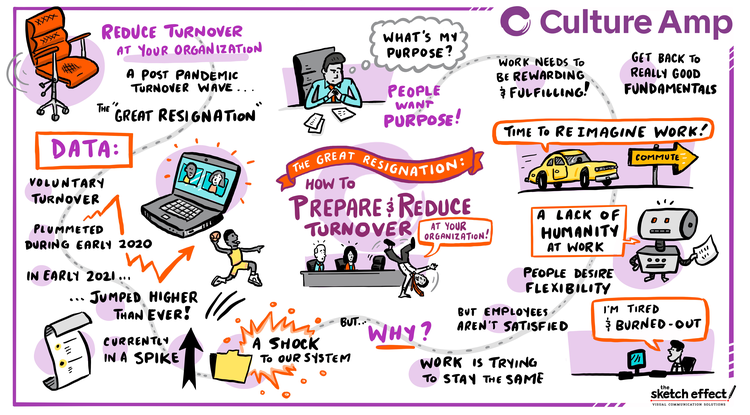
The Great Resignation: 4 ways to prepare & reduce turnover

Written by

Senior Content Marketing Manager, Culture Amp
The pandemic has redefined - or revealed - what really matters to many people. And for a good number of Americans, the uncertainty binding them to unfulfilling work or toxic corporate culture has receded alongside (hopefully) the worst of the pandemic. People have had months to rethink what work means to them, what it means to be valued, and how they want to create value in the world. As the country and companies push ahead with their reopenings, millions of workers are taking the leap and leaving their jobs.
Below, we’ll take a look at the phenomenon now known as the “The Great Resignation” and offer explanations for why it’s happening and what companies can do to retain remaining talent and reduce the impact of potential turnover.
What is the “Great Resignation?”
Anthony Klotz coined the term “The Great Resignation” to refer to the idea that a significant number of people will leave their jobs post-pandemic.
In an article, Anthony explains:
“Due to the uncertainty caused by the pandemic, many employees who would have otherwise quit their jobs stayed put … As the pandemic subsides, these would-be quitters who ‘sheltered in place’ last year will likely enact their plans to leave.”
Put another way - there was (and still is) a backlog of employees who are ready and raring to quit their job for a new opportunity. His prediction appears to ring true - the U.S. Department of Labor reported that a record 4 million people left their jobs in April 2021 alone - the highest number since they started collecting the data.
Likewise, a Microsoft report found that 41% of employees were likely to consider leaving their current employer within the next year, with 46% planning to make a significant pivot or career transition. In consideration of this, employers shouldn’t expect the wave of resignations to end anytime soon. According to the latest data, 3.6 million people quit their jobs in May 2021, a level of churn that is lower than was experienced in April 2021, but a high number nonetheless.
Turnover brings with it emotional stress for current employees and high operational costs for companies. Given that the “Great Resignation” is already sweeping the world of work, how badly should you expect turnover to impact your workforce? Well, the answer depends on both your past and future actions and decisions.
What factors are fueling the “Great Resignation?”
There are several reasons why people have been leaving their jobs. Some of these factors have been recontextualized during the pandemic, while others have emerged due to the pandemic. Here are just some of the factors fueling this period of extreme turnover:
-
Dissatisfaction with current role and future development. Pre-pandemic, our People Scientists analyzed survey responses of over 30,000 employees who voluntarily exited their organizations. They identified lack of career growth and disappointment with one’s role as two key reasons employees leave. The weight of this factor has likely intensified in the early months of the pandemic, with many companies instituting pay cuts, freezing promotions, backtracking bonuses, pausing benefits, and even furloughing or laying off employees.
Consequently, many people felt like they were working harder than ever for little to no reward or recognition. A good number of companies rolled back these preventative measures in mid-to-late 2020. Still, it’s likely too late to retain certain employees who’ve been languishing personally and professionally for months. Accordingly, CNBC reported that of the 26% of workers planning to leave their employers after the pandemic, 80% are doing so because they’re concerned about their career advancement. - Looking for a new career or life path. Over the past year, people were home more than ever before, allowing for extended periods of reflection and exploration. The pandemic has exposed the fragility of daily life, and many folks are reassessing their goals and what it means to spend their life meaningfully. This introspection, alongside shelter-in-place and lockdowns, is likely one reason many MOOCs (massive online open courses), online learning platforms, and boot camps experienced an influx in participation and enrollment during the pandemic.
-
Lack of humanity at work. Many employees looked to their companies for understanding and empathy during the pandemic. Depression and anxiety were prevalent, and many folks dealt with overwhelming stress and isolation. What we thought of as “normality” was replaced by a repetitive loop of daily life brimming with stress, uncertainty, and a seemingly endless stream of crises.
In an interview with the BBC, Alison Omens, Chief Strategy Officer of JUST Capital, explains, “The thing people care about most is how companies treat their employees … The early days of the pandemic reminded us that people are not machines.” For that reason, companies that have failed to acknowledge, respond to, or support people’s humanity at work is likely to suffer a lot of turnover in the coming months. -
The desire for more flexibility. Millions of Americans worked remotely for the first time during the pandemic and have come to enjoy it. Many employees are now reluctant to give up work-from-home and return to the office.
A Morning Consult survey reported that 39% of respondents said they'd consider quitting if their managers weren't flexible about working from home. A similar survey conducted by FlexJobs reported that 58% of participants agreed they would "absolutely" look for a new job if they couldn't continue remote work in their current role. Thus, organizations looking to move back to the office full-time may find that many of their employees would rather quit than return to “normal.” - Disappointment in their company's response to social movements. After the past year’s events, many employees of color and their allies are demanding more on the social justice front from their employers. How companies choose to respond to Black Lives Matter, Stop AAPI Hate, and other social justice movements have become reckoning points, especially among the younger generation. Companies that refuse to engage in conversations about social justice - or aren’t delivering on their promises of solidarity - have likely alienated both current and potential talent. In other words, don't underestimate the impact DEI can have on the talent race.
Looking forward: What organizations can do to retain talent and reduce turnover
Chances are your organization has already experienced or is currently experiencing higher-than-usual levels of turnover. And although it’s too late to change the minds of employees who’ve already left, you can still improve the experiences of employees who’ve chosen to stick around.

Here are a few ways you can retain talent and reduce future attrition:
-
Conduct a survey. Engagement starts with understanding your employees. Done right, surveys can uncover critical insights about where your employees are experiencing the most friction. It’s good to note that not all employees can be “saved”; not every pain point can be resolved quickly enough to make a difference in a given employee’s decision to leave or stay.
That’s precisely why conducting a survey can be so helpful for weathering “The Great Resignation.” By collecting and analyzing feedback from those who have left during the pandemic, you can pinpoint why people are leaving and take action on the areas (e.g., remote work options) that will drive the greatest impact. Culture Amp’s Employee Engagement tool makes it easy with science-backed survey templates for engagement, the onboarding and exit experience, DEI, turnover prediction, and more. - Offer flexible work options. The pandemic has proven that remote work is working. As a result, many employees feel it’s reasonable to expect the option to work from home at least some of the time. If your employees feel like their voices aren’t being heard, they’ll be more likely to leave – especially if there’s little to no justification for going back to the office full-time.
-
Clearly communicate return-to-work plans. Lack of clear communication can be a significant factor in turnover. A McKinsey survey found, “Employees feel they’ve yet to hear enough about their employers’ plans for post-COVID-19 working arrangements. Organizations may have announced a general intent to embrace hybrid virtual work going forward, but too few of them, employees say, have shared detailed guidelines, policies, expectations, and approaches.”
Now that the country is reopening and the job market is hotter than ever, employees may choose to leave for a company that promises them what they want from the offset rather than deal with the anxiety and lack of clarity. - Put employee development first. The pandemic left many people feeling stagnant and ready for anything new and exciting. If you haven’t already, now is the time to proactively and transparently create pathways for employee growth and development. If internal career pivots are possible, make sure employees are aware of them. Encourage managers to dig deeper into their direct reports' goals during their 1-on-1 conversations and empower them with the tools and resources they need to achieve their goals.
Last but not least, put company culture first. We may be biased on this front, but we sincerely believe that companies can ward off the worst of “The Great Resignation” by holistically focusing on employees’ experiences at work. People choose to join a company for various reasons, but company culture is why people ultimately decide to stay.
As our CEO Didier Elzinga wrote, “If you don’t deliver on your culture in a crisis, then your culture meant nothing to start with. And when you stand successful on the other side, your culture will be why.”




